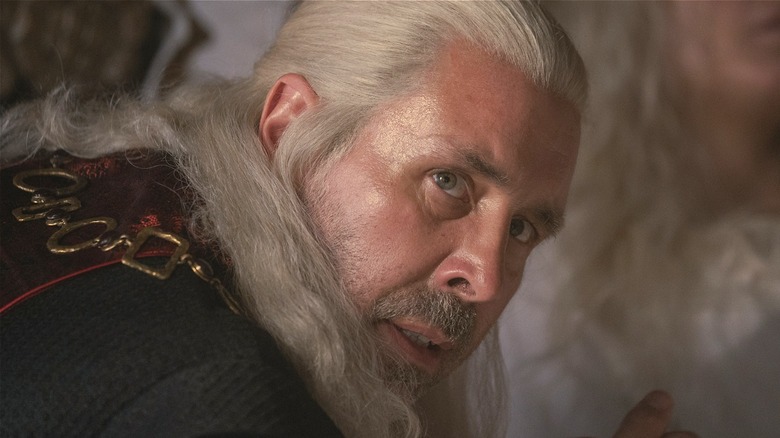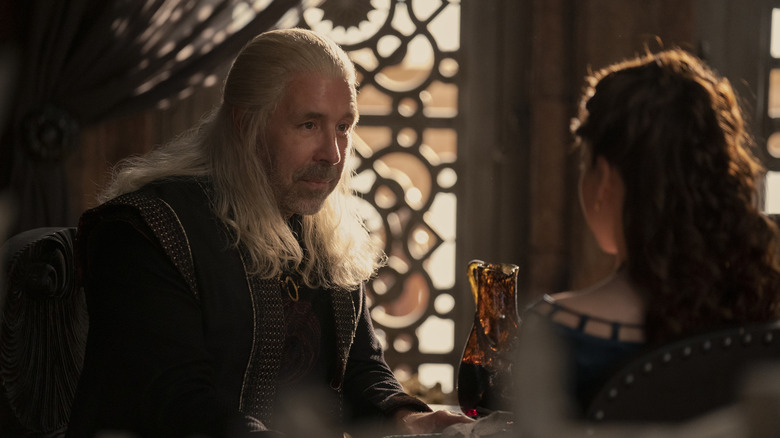House Of The Dragon's Cringe-Worthy Episode 2 Scene Is Surprisingly Accurate
This sequence from "House of the Dragon" probably grossed a lot of fans out... but the fact is that it's shockingly realistic for a show that features giant dragons flying around.
The already successful "Game of Thrones" prequel — so successful, in fact, that it's already been picked up for a second season — is already following in its predecessor's footsteps in some ways, and it's certainly not shying away from gross, icky on screen moments. In the series premiere, audiences were treated to some light wound lancing courtesy — pus included! — thanks to an injury incurred by King Viserys I (Paddy Considine), a few completely smashed faces, a terrifyingly brutal childbirth scene, and jousting fights gone very, very wrong. Episode 2, "The Rogue Prince," followed suit once again, and one of the scenes sure to gross out even the steeliest of fans is one where Viserys, who has cut his finger on the Iron Throne, puts his hand into a bowl of maggots as a form of treatment when the digit contracts what appears to be gangrene.
This maggot-centric scene might seem just as implausible as the aforementioned dragons, but you might be surprised to learn that it's a real medical practice — and it's actually done a ton of good. Here's the reality behind the most cringe-worthy scene in "House of the Dragon" season 1 episode 2.
Medical maggots are a very real thing
You might not expect to see sound medical practices in a show like "House of the Dragon," but according to an in-depth interview over at Inverse, using maggots to excise dead or damaged tissue is an effective and standard medical procedure. Inverse spoke to Swansea University professor Dr. Yamni Nigam, a huge advocate of using medical maggots.
According to Dr. Nigam, the use of medical maggots dates back to a time that looked a lot more like "Game of Thrones" than present day does, saying, "The oldest record of the positive association between maggots and human wounds is in the Bible, in the book of Job. We know there are reports of ancient tribes and cultures, in the Mayan Indian tribe they were known to soak cattle blood on white cloth and hang it up to the sun where it was infested with flies that laid their eggs, they would hatch into maggots. The minute that that cloth was wriggling, they'd put it on various lesions."
So why maggots? Well, as bacterial strains became more resistant to antibiotics, medical maggots made a comeback, as they'd largely become obsolete thanks to those very antibiotics. Maggots only eat dead tissue, never healthy tissue, so ultimately, it's a gentler and very effective way to treat infections, ulcers, and so on. Medical maggots might be quite helpful in some circumstances, but the idea's still... kind of icky.
What medical ailment will Viserys develop next?
The accuracy of those medical maggots aside, it's pretty troubling that King Viserys even needs them in the first place. From leeching to maggots, Viserys has not one, but two health issues that don't seem to be improving at all, and this is a crucial time for the king, as his line of succession feels shaky.
Sure, Viserys names Rhaenyra (played in her youth by Milly Alcock), his firstborn and only child, as his heir after serious misbehavior from his wayward brother Daemon (Matt Smith). However as players like "The Queen that Never Was" Princess Rhaenys (Eve Best) point out, the idea of a woman taking the Iron Throne is not just ludicrous to many in Westeros, but it could be an impossibility.
Clearly, Viserys needs a male heir — he already sacrificed his wife's life to try and get one, only for the infant to die mere hours later — and his myriad of health issues are definitely going to become a bigger concern as the first season of "House of the Dragon" continues. However, whether or not the maggots make a grand return to this small screen universe remains to be seen.


